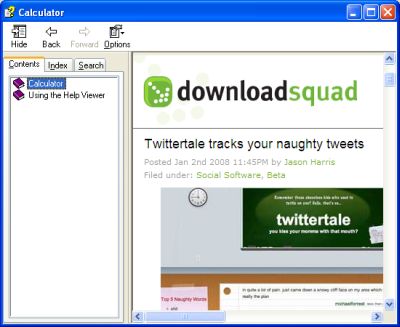No Browser For Surfing? Get Some Help
It’s hard to imagine being somewhere that locks down the web browser so much that you have to resort this nifty trick I read on DownloadSquad.com, but desperate times call for desperate measures. If you can’t reach the web through Internet Explorer due settings beyond your control and forgot your portable Firefox thumbdrive then simply open up the calculator or MS Paint and click “Help”. From there go to “Help Topics,” which will bring up a help window. Now all that is left is to right click on the title bar and select “Jump To URL.” Type in any web address you like, but make sure to include “http://” at the beginning and you should be good to go.
What you are basically looking at is a stripped-down, basic version of Internet Explorer which is built into Windows and used to display CHM files, or Microsoft Compiled HTML Help files. Sure there are no niceties like bookmarks or your comfy, cozy Firefox extensions, but if you need to check your e-mail or Twitter account and this is your only resort, you will put up with a little cruft in order to get your stuff. Besides there are back and forward buttons, what else do you need in a browser?



Just to make it clear, this might not help people who work somewhere with Web filtering; it’s for people who don’t have access to Internet Explorer (or another browser) at all.
I tried it at my company that blocks certain things (proxies, video, my Web site’s log-in) and none of those worked — which makes sense because they’re probably filtering at the protocol or packet level.
Reply
This is very handy, i have come across people wherein their IE8 have failed and there are no other browsers available on their PCs, now i can download other browsers from here! very very good Info!! Thanks
Reply
Great.
Reply
Web design is a broad term covering many different skills and disciplines that are used in the production and maintenance of websites. The different areas of web design include, web graphic design, interface design, authoring, including standardised code and proprietary software, user experience design and search engine optimisation. Thanks.
Regards,
Reply
Web designers use a variety of different tools depending on what part of the production process they are involved in. These tools are updated over time by newer standards and software but the principles behind them remain the same. Web graphic designers use vector and raster graphics packages for creating web formatted imagery or design prototypes. Thanks.
Reply